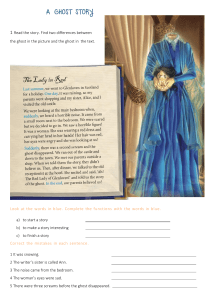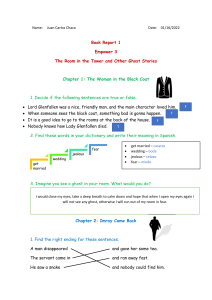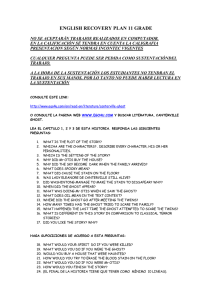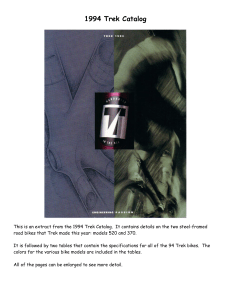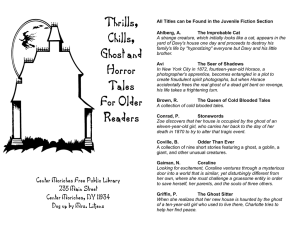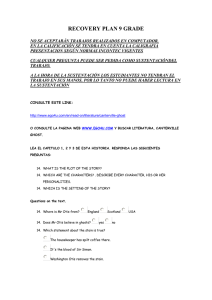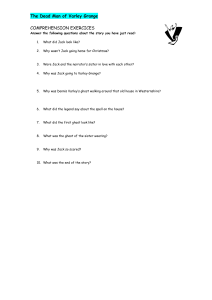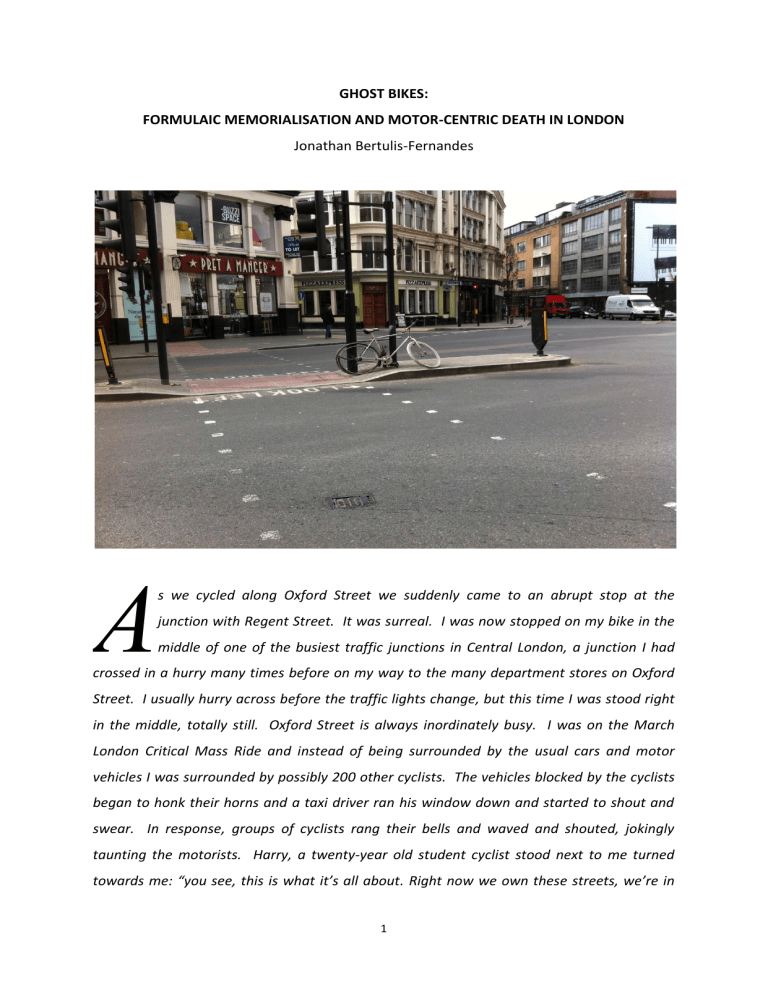
GHOST BIKES: FORMULAIC MEMORIALISATION AND MOTOR-CENTRIC DEATH IN LONDON Jonathan Bertulis-Fernandes A s we cycled along Oxford Street we suddenly came to an abrupt stop at the junction with Regent Street. It was surreal. I was now stopped on my bike in the middle of one of the busiest traffic junctions in Central London, a junction I had crossed in a hurry many times before on my way to the many department stores on Oxford Street. I usually hurry across before the traffic lights change, but this time I was stood right in the middle, totally still. Oxford Street is always inordinately busy. I was on the March London Critical Mass Ride and instead of being surrounded by the usual cars and motor vehicles I was surrounded by possibly 200 other cyclists. The vehicles blocked by the cyclists began to honk their horns and a taxi driver ran his window down and started to shout and swear. In response, groups of cyclists rang their bells and waved and shouted, jokingly taunting the motorists. Harry, a twenty-year old student cyclist stood next to me turned towards me: “you see, this is what it’s all about. Right now we own these streets, we’re in 1 charge and we control the roads.” Daniel, an older, more experienced cyclist and a Critical Mass regular with whom I had chatted earlier joined in: “at the moment everything is focused on people and their cars. Through this we’re showing them now that this isn’t how it has to be. If everyone got out of their cars and went cycling together everything would be fine and everyone would be safe. There is no need for cars, they are just dangerous – they kill so many cyclists each year and no one cares…” Introduction In this project, I examine ghost bikes, a form of roadside memorial placed at the site of a cyclist’s death. I see them as fundamentally different from other forms of roadside memorials; they follow a definite structure and pattern, what I term ‘formulaic memorialisation’. A fair amount of anthropological scholarship already exists on how roadside memorials serve as a way of mediating emotions resulting from the inherently sudden and violent nature of road deaths. Whilst acknowledged that memorialisation is itself a political act, current anthropological thought deals with this almost incidentally. In this project, I argue ghost bikes need to be understood differently, given what I see as their sui generis nature. I see ghost bikes as taking on a much more pronounced dual-role. Their uniform nature as memorials, this ‘formulaic memorialisation’, ties into notions of cyclist collectivity and identity. Whilst they act as a way of marking and commemorating the death of someone on the road, linked to this, I argue that they also serve an overtly political purpose as a way of attempting to protest against what I term “motorcentric death”. I carried out my fieldwork during two weeks in London. I visited various ghost bikes and conducted interviews with different cyclists and cycling groups. It has been a privilege working with my informants and I am truly grateful for their candour and the trust they have shown me. This project is about them, their experiences, views and opinions. Cyclists are not monolithic and I have tried to avoid essentialising experiences. My interpretation of these thoughts, rooted in anthropological theory and scholarship, is merely one potential, generaliseable understanding to explain this phenomenon. 2 Ghost bikes: an examination Formulaic memorialisation Ghost bikes differ from other ‘roadside memorials’ in two distinct ways. Firstly, they involve the deliberate creation of a memorial in a specific form, typically by a group of people following a set pattern or formula dictating the basic structure of the memorial. Secondly, ghost bikes are uniform in this image, insofar as a common object or symbol is used by often disparate and disconnected people as part of individual and personal memorialisation. Ghost bikes are thus deliberately constructed as an object with wider significance beyond the individual memorialisation. Current anthropological scholarship on what Dobler terms ‘vernacular memorials’ (2008:3), memorials existing outside official or institutionalised forms of memorialisation, mainly focus on ‘spontaneous shrines’ (Dobler 2010:4). These are flowers, crosses or ‘makeshift’ shrines that grow organically in the aftermath of a road death – placed by family members, friends and other individuals (ibid). These are formed by the cumulative product of the contributions and actions of disconnected and disorganised individuals (Everett 2000). The actions of these formally disconnected individuals make up the parts that result in the whole, the memorial. By contrast, all of the ghost bikes I visited in London followed a definite, prescribed structure and were the result of a definite and deliberate process – typically the result of a formalised network of people working towards a pre-imagined goal. I term this structured and deliberate aspect as opposed to the spontaneous and organic creation of other roadside memorials ‘formulaic memorialisation’. In this section, I examine ghost bikes and their constitution before comparing them to other ‘roadside memorials’ in order to delineate clearly the key differences I view marking ghost bikes as different from other roadside memorials. During my fieldwork, I visited ten ghost bikes in various parts of London. All of the ghost bikes I visited followed the same formula; they were typically built from spare parts assembled to form a bike. The bike was then painted white and physically attached to an item of street furniture such as a bench or lamppost near the location of a cyclist’s death. An example of a ghost bike in Islington, that of an Australian cyclist James Foster, is shown below: 3 Some bikes showed more ‘personalisation’, incorporating elements representing the cyclist killed - for instance, one ghost bike opposite King’s Cross Station marking the death of student Min Joo Lee in King’s Cross had a box of sushi attached to it: As the ghost bike for Min Joo Lee (nicknamed Deep Lee) above shows, some also had laminated sheets of paper attached with the name of the cyclist and a short passage. 4 Others showed varying degrees of decoration, such as the ghost bike marking the death of cyclist Dan Cox, in Hackney: The level of apparent decoration seems to decrease with the length of time the ghost bike had been in situ, ranging from the first ghost bike pictured which was placed in 2008 to the one for Dan Cox (above) which was placed in 2011. 5 The ghost bike for Eilidh Cairns (above) shows alternative forms of ‘decoration’. However, as can be seen in the pictures above, despite these differing levels of ‘decoration’ or ‘personalisation’ all ghost bikes clearly follow the same formula or pattern - a bike painted white and fixed at a spot at or near the place where the cyclist died. This is in contrast to other forms of roadside memorials. These are spontaneous, ‘temporary memorials’ consisting of ‘assemblages of flowers and personal artifacts [sic] that appear at the site of a traumatic death or catastrophic event’ (Dobler 2008:4 my parentheses). As Santino (2003:51) observes, these are constructed at individual people’s motivations - terming them ‘spontaneous shrines’ to reflect the disconnected individual actions which together cumulatively result in the totality of a roadside memorial: Roadside memorial in Hillcrest Heights, Maryland – 2013 (Washington’s Other Monuments:2013) © Lloyd Wolf / used by permission. All rights reserved. http://lloydwolf.com/?page_id=119 6 Roadside memorial in Lynnhaven neighbourhood, Alexandria – 2013 (Washington’s Other Monuments:2013) © Lloyd Wolf / used by permission. All rights reserved. http://lloydwolf.com/?page_id=119 These pictures of several roadside memorials show this key contrast. They represent the product of cumulative individual actions resulting from individual motivations – various flowers, balloons and other objects have been placed by different people to create the overall memorial. Fraenkel (2011:231) observes how shrines and roadside memorials such as those marking the terrorist attacks of September 11 th 2001 consist of, at a base level, assemblages of various objects, cards and flowers brought by different individuals – these individual actions thus constructing an overall memorial. Whilst the individuals may have an idea or a cognitive image of what a memorial should appear like, the individuals themselves are not working towards the creation of a specific overall image of a memorial. In clear contrast, however, ghost bikes are the result of the collective action of a group of people deliberately following a pre-determined, definite pattern and structure, which is repeated by disparate and disconnected groups of people. Those creating a ghost bike thus set out to deliberately produce a memorial that has a wider meaning and significance beyond simply the event of individual memorialisation – enmeshing it within a wider cognitive web of meaning. 7 I term this ritualised and structured pattern ghost bikes follow ‘formulaic memorialisation’. That is, the structured and formularised act of memorialisation, which ghost bikes represent. One of my informants, a woman who runs a website on memorials and is an active cyclist, sees ghost bikes as eminently less spontaneous than other road side memorials. She preferred to be listed in this paper as ‘London Remembers’, the name of her website: ‘most road side memorials are totally unorganised, they are just… people do it because they want to do it without any planning. But when it comes to a ghost bike that moves the whole thing on a stage because that does require planning… It’s quite a little project putting up a ghost bike, it requires a lot of work and organisation’. Another one of my informants, Anthony Austin, who is coordinator of Greenwich Cyclists (a cycle group in South London) described how he and other cyclists, upon hearing about ghost bikes in America, constructed and placed a ghost bike at the site of three cycling fatalities in Greenwich. Ghost bikes, therefore, seemingly take on an organised and structured element following a specific formula. In contrast to other roadside memorials, these individual bounded events of remembrance and commemoration occur within a collective structure – following a definite, prescribed formula as to what form the memorial should take. They thus represent a collective and common form of expressing individual emotions. Ghost bikes are sui generis and differ from other roadside memorials in this key way. Whereas other spontaneous roadside memorials primarily act as a way to mediate emotions of grief and loss (Everett 2000), ghost bikes serve a different and dual purpose beyond this. I examine this dual purpose in the following sections. Dual purpose: remembrance and protest I see this ‘formulaic memorialisation’ as tying into notions of cyclist collectivity, community and identity. Simultaneously, it is also suggestive of a dual purpose for ghost bikes beyond simply the memorialisation of a violent death. Current anthropological scholarship focuses on ‘vernacular memorials’ as centred on commemoration and 8 remembrance. I see ghost bikes as incorporating this but also having a much more pronounced protest capacity. In this section, I explore this dual purpose of ghost bikes, both as an act of remembrance and an act of protest and resistance. A bike of remembrance: personalising and marking an anonymous space There is a great deal of anthropological scholarship on the ways in which roadside memorials function as ways of marking and remembering violent, traumatic death. Everett (2000:98) details how families of road traffic accidents in Texas create roadside memorials as a way to ‘visit and mark the site of a tragedy’. Families attempt to engage with the notion of their loved one losing their life in such a violent way by creating something at ‘the last place where their loved one was conscious, and thus really "alive"’ (ibid). Those who I interviewed expressed similar sentiments when discussing ghost bikes. For them, ghost bikes became a way of marking the location where their loved one lost their life. Amongst those I interviewed, an aspect that they commonly found particularly difficult was that the death had occurred in an inherently public space. A death on the road breaks the usual public-private binary - something incredibly personal takes place in a public area amongst strangers. My informants described how they often struggled with the fact that their loved ones died in such an anonymous and transitory space – one that is not a destination in itself, but rather simply a space through which one travels. I got a painful sense of what people felt was the utter ignobility of the circumstances of their loved one’s death. Kozak’s cross-cultural model of ‘good/bad’ and ‘natural/unnatural’ death (Kozak 1991:213) argues for a binary function in the way in which people comprehend and respond to death. A ‘good death’ is one that is natural such as from old age or any ‘expected causes’, whilst ‘bad death’ describes something sudden, unpredictable and violent. Indeed, one of my informants, founder of the charity RoadPeace, Brigitte Chaudhry, whose son was killed by a van driver in 1990, described how painful she found this: ‘they have died, on their own or amongst strangers. And that’s what hurts us so much, that we were not there, that they died in a public space. In a busy place with… just people who didn’t care about them around them’. 9 There is a sense of a contrast between the individuality of the person and the sheer anonymity of the space in which they died. This standardised and almost ‘identikit’ nature of the space engenders a feeling of a painful ‘continuity’ for the families and friends of those killed on roads. Many described to me their feeling that something extremely violent and life changing had happened but there was nothing physically reflecting that, one described to me this feeling: ‘it’s as-if it feels like something should have changed, but everything just carries on and everything looks the same and no one knows anything about it’. Another cyclist described to me how he witnessed council workers replacing fencing, damaged in a fatal accident involving a cyclist a couple of days earlier: ‘they put up that grey fencing they have everywhere and as soon as they’d done that it was as if nothing had happened and everyone could just get on with their lives as normal’. Another informant, Mark Ames, a young cyclist who runs an online cycling blog described this further: ‘in somewhere busy like Central London, if someone’s killed on a Monday, by the Wednesday everything’s back to normal and… except for the people who were there at the moment the cyclist was killed, no one would ever know it had happened…’. Moreover, the experience of dealing with a multitude of official agencies and formal structures in the immediate aftermath of the death adds to this sense of the anonymous. This is also compounded by the fact that families are often not able to see the bodies of their loved one due to the severe injuries they often suffer in the crash, nor is the bike returned to them as it is often held for evidence. This leaves families without any tangible physicality to the death, complicating an already extraordinary grieving process by virtue of the ‘bad death’. Brigitte described the moment she was informed of her son’s death: ‘Like for all too many members of our charity, a policeman’s knock on the door changed my life forever… My son had been taken by air ambulance to hospital, but nobody called me then. The police came hours later to tell me he had died, but stating “you will not be allowed to see him”. And because of the shock, I didn’t protest…..Now I can’t understand why I allowed this to happen… I think I still didn’t believe it, thought they must be wrong - I asked “what proof have you got?” And, incredibly using jargon in such a situation, the policeman said: “by the property we found on him”, never describing what it was, nor informing me that 10 my son was the innocent victim of a red light violator. I kept on phoning my son and had his answer machine again and again…’ This leaves the death of the loved one as an almost abstract idea, divorced from any physical sense of reality. Brigitte described this interstitial feeling, as the death is so different to the expected, ‘good death’: ‘it just leaves you in limbo, you don’t believe it quite, and, it’s like somebody goes on holiday and doesn’t come back… and you can pretend they are still there…’ Through the ‘memorial complexes’ (Everett 2000:98) of installing a ghost bike it is possible to create something which physically alters and marks an otherwise indistinguishable and generic space. Mark described it as: ‘In installing this ghost bike it’s a bit like painting a white outline of someone who’s died on the street, you know, it’s making a sort of a indelible and permanent ghostly impression of what’s happened…’. This notion of a ‘ghostly impression’ is extremely interesting anthropologically. Connerton’s work on social memory (1989) shows how material objects in commemorative ceremonies evoke emotions and collective conceptions. Indeed, Lynn Wagner (2011:7) also argues memorials to be ‘a powerful mechanism that interpolates sacred value to place’ through the evocation of emotions and memories through material objects. This is something, which London Remembers also noted: ‘just by looking at the bike, conjures up for the person looking at it the idea of a person on the bike. So a ghost bike is almost making you think of a person sitting on the bike, the person who died, although obviously the bike isn’t their bike… it’s almost like it conjures up the shadow of the person who used to ride it.’ The placing of ghost bikes therefore creates something tangible and alters a previously anonymous space to reflect the occurrence of the violent, ‘bad’ death of the cyclist. This space is changed both physically, through the erection of the ghost bikes, but also cognitively and sociologically through the creation of these loci of memory and emotion. London Remembers told me the way in which she viewed and experienced certain areas had been altered by ghost bikes as physical locations became bound up with webs of 11 meaning and collective memory structures: ‘It’s changed King’s Cross for me, entirely, I, you know, I know where that ghost bike is, I can’t go anywhere near it without looking at it’. Therefore, ghost bikes offer a way of mediating feelings of grief and loss linked to notions of a ‘bad’ death and the anonymous circumstances of the cyclist’s death. A bike of protest: resisting motorcentric death Simultaneously, I see these notions of the marking an anonymous space as bound up with wider notions of protest and resistance. Margry and Sanchez view memorials as constituting a form of ‘social action’ through which social discontent can be expressed (2011:2). The act of memorialisation is inherently interlinked with the idea of protest and political participation (ibid:28). However, inextricably linked with their ‘formulaic memorialisation’ aspect, I see ghost bikes as incorporating a more deliberate and over protest element than other memorials. Many of my informants spoke to me about what they felt was the unique community and collective aspect to cycling. Oliver Jeffcot, a keen cyclist and solicitor specialising in civil law involving cyclists told me: ‘cyclists definitely flock together, and communities of cyclists exist very strongly… it’s incredible the number of people who meet up every week and go for rides together’. Moreover, Mark described the ways in which he felt being a cyclist was a definite identity for some: ‘No one is born a cyclist, you go through a stage where you purposefully make yourself an outlier kind-of member of society by becoming a cyclist.. they make themselves a minority… this taps in to people feeling part of a bigger group and, yeah, this idea of a band of brothers…’. I see the ‘formulaic memorialisation’ aspect of ghost bikes as tying in to this notion of cycling collectivity, community and identity – the use of a common symbol of a bike to mark the death of cyclist hints towards this collective notion. Moreover, the London Fixed gear and Single-speed internet forum includes a sub-section titled ‘Rider down’ to document fatalities and vehicle-collisions involving ‘riders’ or cyclists (London Fixed gear and Singlespeed forum). Analysing this with reference to Connerton’s theory on commemorative 12 ceremonies facilitating an understanding of current collectivity and social order (1989), coupled with Turner’s (1995[1969]:96) notion of ‘communitas’, provides an interesting perspective on the community aspect to this ‘formulaic memorialisation’. Turner sees rituals and ceremonies, in this case the process of ghost bike construction and installation, as being made up of three stages through which the ‘structure’ of ‘recognised cultural topography’ (Turner 1967:97) is removed, engendering a sense of a commonality, or ‘communitas’, amongst the ‘neophytes’ [the cyclists]. Therefore, this formulaic memorialisation provides an avenue for an expression and consolidation of a notion of a commonality or ‘communitas’ amongst cyclists. This tension between the individual act of memorialisation and the wider webs of meaning resulting from formulaic memorialisation also portrays clearly a political element. By virtue of their uniform appearance stemming from formulaic memorialisation, ghost bikes become a recognisable and easily comprehendible symbol. Individual cyclist deaths are thus enmeshed within wider sociological networks of political and protest meaning. Anthony, whilst describing his group’s rationale for placing ghost bikes at the locations of cyclists’ deaths, told me how he and his cycling group in Greenwich viewed cyclists’ deaths as far more than an individual tragedy. Instead, individual cyclist deaths became a public concern: ‘It was in the public domain, it was an accident involving a motorist and a cyclist. And we, as cyclists, were indignant about that and we wished to make a point that this was an unnecessary death so-to-speak.’ Just as individual cyclists’ deaths occur in a public arena against a backdrop of concerns over road safety, so too are individual ghost bikes placed within this wider collective structure resulting from their uniformity and formulaic memorialisation aspects. Linked to this, my informants spoke about the way in which they felt ghost bikes on one level constituted a protest against a society that fails to take road safety issues and vulnerable road users seriously. Oliver described how as a cyclist he felt almost subordinated and othered by motor vehicles: ‘…cyclists feel ostracised from their community… not really respected and endangered by drivers unnecessarily and unfairly... it can feel quite impotent being a cyclist at some times’. He went on to say: ‘we’re living in a 13 motorcentric society in which driving is massively subsidised and it’s… driving is treated like nothing else is, it’s given so much for something which is potentially so dangerous and pollutant and problematic, it’s given so much leeway’. This was a common theme amongst my informants and many spoke about what they saw as the dominance of motor traffic and vehicles, which endangers and kills cyclists unnecessarily. With some echo of structural violence notions (Galtung 1990), there was a sense that the way in which this motorcentric society was structured, organised and, indeed internalised, allowed for and perpetuated this dominance of motor vehicles over cyclists and other vulnerable road users. Many spoke to me of how roads and traffic junctions were often designed to favour the quick movement of motor vehicles whilst often placing cyclists in danger. Moreover, many spoke about how they felt cyclist deaths were treated almost as an inevitability by society. Indeed, London Remembers was at pains to avoid the word ‘accident’ when being interviewed by me: ‘… for people killed on the road, I am very careful to avoid the word “accident” because it’s not an “accident”, it’s a crash, an accident suggests it was unavoidable’. For my informants, through marking the deaths of cyclists ghost bikes also became a way of attempting to resist these motorcentric societal structures which resulted in what I term, ‘motorcentric death’ - the notion that cyclists are unnecessarily killed due to the hegemonic societal dominance of motor vehicles. . Many of my informants spoke about the protest nature they saw ghost bikes as taking on, Mark said how: ‘a lot of people who have been killed on bikes have been killed by drivers who will later testify “oh, I never saw them”, and we have this kind-of common phrase in cycling circles which is: SMIDSY which stands for “Sorry mate, I didn’t see you”… people put these white bikes in place, always in very prominent places as an almost two-fingered gesture to say: “do you see me now?”… It’s more about saying: “We’re here [the cyclists] and we have always been here’ (my parentheses). I also encountered elements of this protest discourse also at the London Critical Mass ride I participated in at the end of March, as detailed at the start of this paper. A group of cyclists meet up at a pre-agreed location and then ride together through London in an attempt to exceed the number of cars and motor vehicles. Cyclists taking part in the ride flouted traffic 14 laws, refusing to stop at red lights and purposefully blocked motor vehicles and prevented them from moving – in an attempt to control and manipulate motor traffic. In Weapons of the Weak (1985:304), Scott argues that those subordinated beneath a cultural hegemony, as in the case of cyclists in a motorcentric society, respond with ‘everyday’ or ‘routine’ forms of resistance (ibid:255). Where this is effectively whatever means are available. Thus, cyclists can be interpreted as resisting ‘motorcentric death’ through one of the potential means open to them. Through the marking of cyclists’ deaths by a personalisation of this anonymous, motorcentric space, cyclists attempt to assert their identity and presence collectively against a perceived cultural hegemony. This resistance reflects the perceived motorcentricity of society and existent power relations (Foucault 1982:780). Ghost bikes thus have a clear dual political and protest role. This is inextricably bound up with their formulaic memorialisation, providing cyclists with a way to resist motorcentric death through a readily understood and clear symbol. Whilst other roadside memorials may also have political aspects, this is often incidental and not as deliberate or overt as ghost bikes. Conclusion Ghost bikes therefore have a dual purpose: both as an act of remembrance and commemoration and an act of protest. Through the personalisation of an anonymous space, ghost bikes mediate emotions of grief and loss - providing a way through which people are able to understand an inherently violent and sudden death. Simultaneously, the use of structured, ‘formulaic memorialisation’ acts as an assertion of a collective identity to cycling and places individual cyclist’s deaths within a wider protest structure. Whilst roadside memorials and the marking of space are inherently political, ghost bikes go further and act as an avenue through which cyclists are able to actively resist and protest against a perceived cultural hegemony in a motorcentric society. 15 References Connerton, P., 1989. How societies remember. Cambridge: Cambridge University Press. Dobler, R., 2010. Alternative memorials: death and memory in contemporary America unpublished thesis (M.A.): University of Oregon. Everett, H., 2000. Roadside crosses and memorial complexes in Texas. Folklore, 111(1), pp.91-103. Foucault, M., 1982. The subject and power. Critical Inquiry, 8(4), pp.777–795. Fraenkel, B., 2011. Street shrines and the writing of disaster: 9/11, New York, 2001. In: J. Margry, P. Sánchez-Carretero and C. Sánchez-Carretero, eds. 2011. Grassroots memorials: the politics of memorializing traumatic death. USA: Bergahn Books. pp.228-243. Galtung, J., 1990. Cultural violence. Journal of Peace Research, 27(3), pp.291-305. J. Margry, P. Sánchez-Carretero and C. Sánchez-Carretero, eds., 2011. Grassroots memorials: the politics of memorializing traumatic death. USA: Bergahn Books. Kozak, D., 1991. Devil sickness and devil songs. Washington DC: Smithsonian Institution Press. London fixed gear and single-speed forum, 2013. Rider down – London fixed gear and singlespeed forum. Available at: <http://www.lfgss.com/forum40.html> [Accessed: 1 May 2013]. London Remembers, 2013. London Remembers, aiming to capture all memorials in London. Available at: <www.londonremembers.com> [Accessed: 1 May 2013]. Lynn Wagner, D., 2011. Death, memory, and space: a rural community response to roadside memorials. Ann Arbor: ProQuest LLC. Turner, V., 1967. The forest of symbols: aspects of ndembu ritual. London: Cornell University Press. ---------- 1969[1995]. The ritual process: structure and anti-structure. Chicago: Aldine Publishing Company. Santino, J., 2003. Spontaneous shrines memorialization, and the public ritualesque. Ritsumeikan, Revista del Instituto de Humanidades, 94(3), pp.51-65. Scott, J., 1985. Weapons of the weak: everyday forms of peasant resistance. New Haven: Yale University Press. 16 Washington’s Other Monuments. 2013. Julian Dawkins' memorial/Lynhaven neighborhood, Alexandria [image online]. Available at: <http://dcshrines.blogspot.com/2013/05/julian-dawkins-memorial-lynhaven.html> [Accessed: 15 June 2013]. Washington’s Other Monuments. 2013. Memorial for Charles Michael Walker Jr, Hillcrest Heights, Maryland [image online]. Available at: <http://dcshrines.blogspot.com/2013/02/memorial-for-charles-michael-walkerjr.html> [Accessed 15 June 2013]. 17
